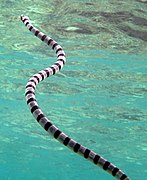Coral reef
A coral reef is an underwater ecosystem characterized by reef-building corals. Reefs are formed of colonies of coral polyps held together by calcium carbonate.[1] Most coral reefs are built from stony corals, whose polyps cluster in groups.
Coral belongs to the class Anthozoa in the animal phylum Cnidaria, which includes sea anemones and jellyfish. Unlike sea anemones, corals secrete hard carbonate exoskeletons that support and protect the coral. Most reefs grow best in warm, shallow, clear, sunny and agitated water. Coral reefs first appeared 485 million years ago, at the dawn of the Early Ordovician, displacing the microbial and sponge reefs of the Cambrian.[2]
Sometimes called rainforests of the sea,[3] shallow coral reefs form some of Earth's most diverse ecosystems. They occupy less than 0.1% of the world's ocean area, about half the area of France, yet they provide a home for at least 25% of all marine species,[4][5][6][7] including fish, mollusks, worms, crustaceans, echinoderms, sponges, tunicates and other cnidarians.[8] Coral reefs flourish in ocean waters that provide few nutrients. They are most commonly found at shallow depths in tropical waters, but deep water and cold water coral reefs exist on smaller scales in other areas.
Shallow tropical coral reefs have declined by 50% since 1950, partly because they are sensitive to water conditions.[9] They are under threat from excess nutrients (nitrogen and phosphorus), rising ocean heat content and acidification, overfishing (e.g., from blast fishing, cyanide fishing, spearfishing on scuba), sunscreen use,[10] and harmful land-use practices, including runoff and seeps (e.g., from injection wells and cesspools).[11][12][13]
Coral reefs deliver ecosystem services for tourism, fisheries and shoreline protection. The annual global economic value of coral reefs has been estimated at anywhere from US$30–375 billion (1997 and 2003 estimates)[14][15] to US$2.7 trillion (a 2020 estimate)[16] to US$9.9 trillion (a 2014 estimate).[17]
Though the shallow water tropical coral reefs are best known, there are also deeper water reef-forming corals, which live in colder water and in temperate seas.
Coral reefs are estimated to cover 284,300 km2 (109,800 sq mi),[59] just under 0.1% of the oceans' surface area. The Indo-Pacific region (including the Red Sea, Indian Ocean, Southeast Asia and the Pacific) account for 91.9% of this total. Southeast Asia accounts for 32.3% of that figure, while the Pacific including Australia accounts for 40.8%. Atlantic and Caribbean coral reefs account for 7.6%.[5]
Although corals exist both in temperate and tropical waters, shallow-water reefs form only in a zone extending from approximately 30° N to 30° S of the equator. Tropical corals do not grow at depths of over 50 meters (160 ft). The optimum temperature for most coral reefs is 26–27 °C (79–81 °F), and few reefs exist in waters below 18 °C (64 °F).[60] When the net production by reef building corals no longer keeps pace with relative sea level and the reef structure permanently drowns a Darwin Point is reached. One such point exists at the northwestern end of the Hawaiian Archipelago; see Evolution of Hawaiian volcanoes#Coral atoll stage.[61][62]
However, reefs in the Persian Gulf have adapted to temperatures of 13 °C (55 °F) in winter and 38 °C (100 °F) in summer.[63] 37 species of scleractinian corals inhabit such an environment around Larak Island.[64]
Deep-water coral inhabits greater depths and colder temperatures at much higher latitudes, as far north as Norway.[65] Although deep water corals can form reefs, little is known about them.
The northernmost coral reef on Earth is located near Eilat, Israel.[66] Coral reefs are rare along the west coasts of the Americas and Africa, due primarily to upwelling and strong cold coastal currents that reduce water temperatures in these areas (the Humboldt, Benguela, and Canary Currents, respectively).[67] Corals are seldom found along the coastline of South Asia—from the eastern tip of India (Chennai) to the Bangladesh and Myanmar borders[5]—as well as along the coasts of northeastern South America and Bangladesh, due to the freshwater release from the Amazon and Ganges Rivers respectively.
Significant coral reefs include:










